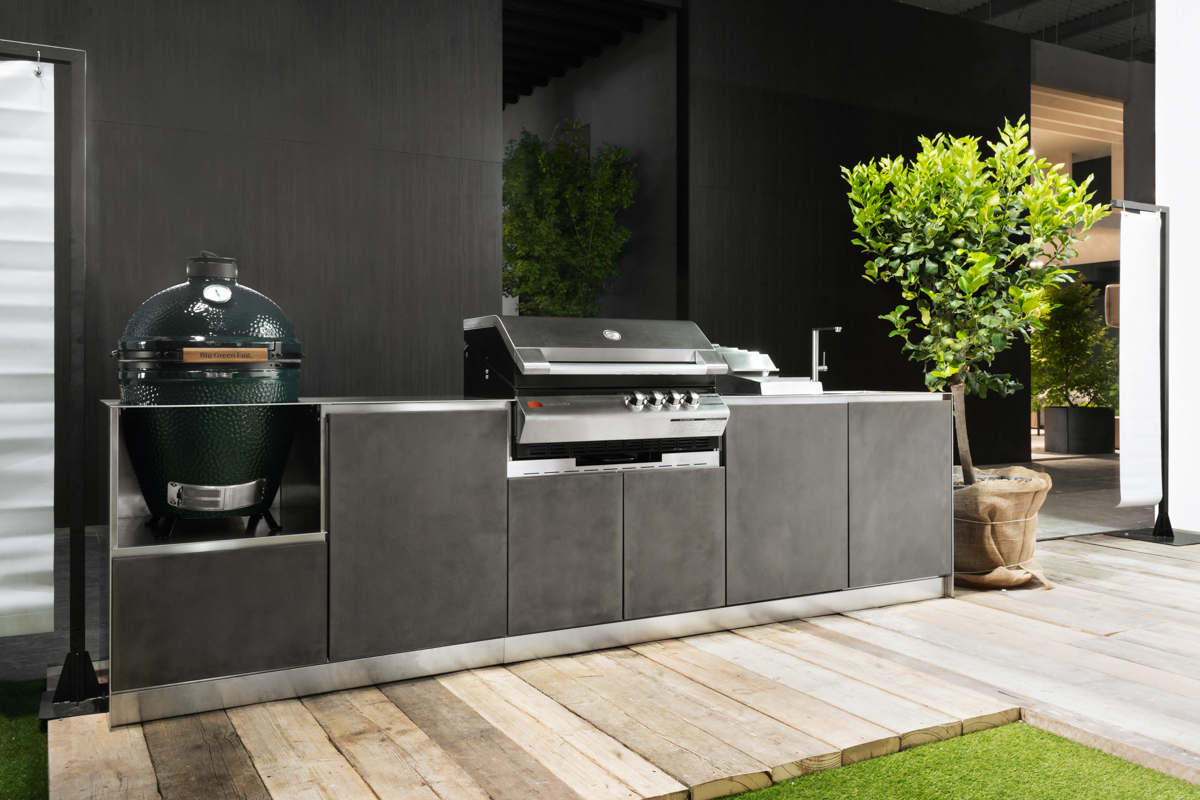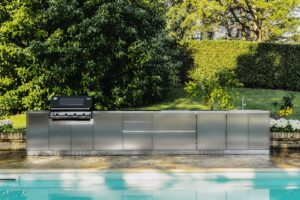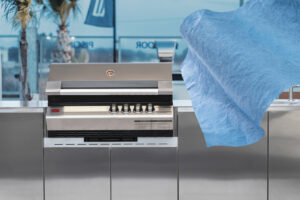Designing an outdoor kitchen is an excellent opportunity to create a functional and welcoming space where you can prepare food and entertain guests in the open air. The kitchen layout is one of the most important aspects to consider, as it affects not only the aesthetics but also the practicality and daily use of the space. Among the most common options today are the linear, island, and L-shaped layouts: three configurations whose characteristics we will examine in this article to help you choose the one that best suits your needs.
Linear outdoor kitchen: the layout that optimizes space
Linear outdoor kitchens are one of the most practical and versatile solutions for those who want to set up an outdoor cooking area without sacrificing style and functionality. This layout, characterized by the organization of elements along a single wall, offers numerous advantages from both an aesthetic and practical point of view, such as:
- Space optimization: the linear kitchen is perfect for maximizing limited or narrow spaces, such as terraces, balconies, and courtyards with reduced surfaces. Arranging all appliances and worktops along a single wall allows you to save space, leaving the surrounding area free for outdoor furniture, tables, or relaxation areas;
- Ease of installation: linear kitchens are relatively simple to install, as they require only one wall on which to place electrical, gas, and water systems. This aspect also reduces installation costs compared to more complex configurations, such as island or L-shaped ones, which might require major structural interventions;
- Modern and sober design: the linear aesthetic is characterized by its cleanliness and simplicity. Especially if made of stainless steel, the contemporary and minimalist character of the linear outdoor kitchen integrates perfectly into modern gardens or refined design terraces. Stainless steel not only guarantees a visually elegant impact but is also highly resistant to weathering, rust, and inclement weather;
- Maximum functionality in a small space: despite its simplicity, a linear kitchen offers everything necessary for comfortable outdoor cooking. It can include a cooktop, sink, food preparation spaces, and integrated storage solutions, such as drawers and deep drawers. The intelligent use of vertical space, with wall units or shelving, can increase storage capacity, making this configuration even more functional.
The linear layout is therefore ideal for those with compact spaces and for those who occasionally use the outdoor kitchen, but also for lovers of minimalist design, always looking for clean and modern aesthetics. Despite their extreme simplicity, limited storage capacity, and limited possibility of interaction with guests, linear outdoor kitchens are highly customizable and versatile, adapting perfectly to every specific need.
Island outdoor kitchen: the solution for large spaces
Island outdoor kitchens are the perfect choice for those who want to transform their garden or terrace into a real meeting point for friends and family. This configuration, with a central island that serves both as a work area and socialization space, combines style, functionality, and a strong visual impact, making the kitchen the focal point of outdoor activities. Its strengths are:
- Convivial design: the island kitchen, unlike traditional compositions where the cook might feel isolated, promotes interaction with guests and is therefore perfect for those who often organize dinners or parties with friends and relatives;
- Large work surface: the central island offers a larger work surface compared to other configurations, often integrated with a cooktop, sink, and storage spaces, ensuring greater comfort during food preparation;
- Flexibility of use: an island kitchen offers great versatility, as it can be used for cooking, preparing, serving food, or even as an area for consuming meals with bar stools. It can also serve as a counter for aperitifs, creating a central area where guests can gather before meals;
- High-impact aesthetics: island outdoor kitchens, especially if made of stainless steel, give the environment a modern, elegant, and sophisticated look that can easily become the focal point of the outdoor space. The island can be designed with custom finishes and premium materials, easily adapting to the style of any home and garden.
Ideal for cooking and entertainment enthusiasts looking for modern solutions for their outdoor spaces and for those with gardens or large terraces, island outdoor kitchens, however, require a greater investment compared to other configurations, especially if custom-made with quality materials such as stainless steel, marble, and wood: an aspect not to be underestimated when choosing the ideal layout for your needs.
L-shaped outdoor kitchen: the compromise between space and functionality
L-shaped outdoor kitchens are undoubtedly the most versatile and functional configurations for those who want to create a well-organized, efficient outdoor kitchen area with great aesthetic impact. This layout maximizes the corners of gardens and terraces, offering spacious and complete solutions that combine functionality and design, without sacrificing comfort and practicality. Its main advantages are:
- Space optimization: the L-shaped kitchen develops on two adjacent walls or sides, making the best use of corners in the outdoor space. This arrangement allows for a larger work surface without occupying too much central space, making it perfect for both large gardens and more compact terraces;
- Ergonomics and efficiency: the L-shaped layout facilitates an ergonomic workflow, where preparation, cooking, and washing areas are easily accessible and close to each other. This makes movements easier while cooking, reducing travel time between different operational areas and increasing productivity;
- Ample storage and work space: thanks to the presence of two perpendicular surfaces, the L-shaped kitchen offers more space for worktops and storage compared to other more compact configurations, such as linear ones. It is indeed possible to use the space under the worktops to insert cabinets, drawers, or outdoor refrigerators, maximizing the capacity for storage and organization of utensils and ingredients;
- Versatility in design: an L-shaped kitchen offers much freedom in terms of design and customization. It can be adapted to different needs, with the integration of appliances such as barbecues, cooktops, sinks, or even pizza ovens.
Recommended for those seeking a compromise between space and functionality, L-shaped outdoor kitchens also leave ample freedom for customization, but require careful planning: it is important to position appliances and worktops strategically, taking into consideration the work triangle (preparation, cooking, and washing), to facilitate movements between various areas and improve efficiency.
Linear, island, or L-shaped outdoor kitchen: what factors influence the choice
The choice of an outdoor kitchen layout depends on several factors, including:
- Available space: if the area is large, you can opt for an island kitchen that allows for more social interaction; if space is limited, a linear kitchen might be the ideal solution;
- Intended use: if you love organizing outdoor parties and lunches, an island kitchen might be more functional, while for more intimate daily use, it will be sufficient to install an L-shaped or linear kitchen;
- Style and personal preferences: if you want to create a modern and impactful space, you will choose an island kitchen, if instead you prefer a more discreet and functional design, the solution will be a linear or L-shaped kitchen.
Choosing the ideal layout for an outdoor kitchen is an important decision that will influence the aesthetics and practicality of any outdoor space. For this reason, it is essential to always have a clear main objective of creating a functional, pleasant environment that, above all, is suited to your needs.






